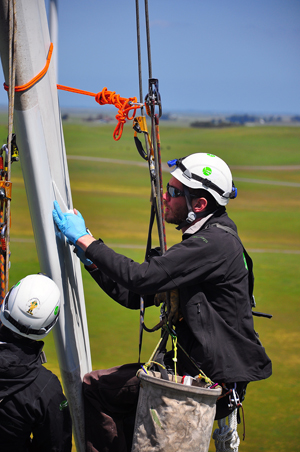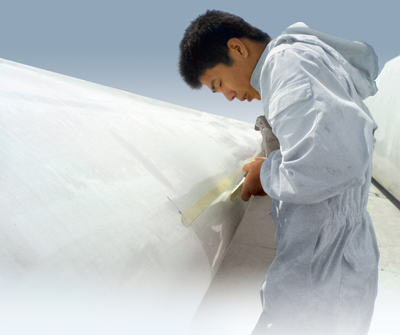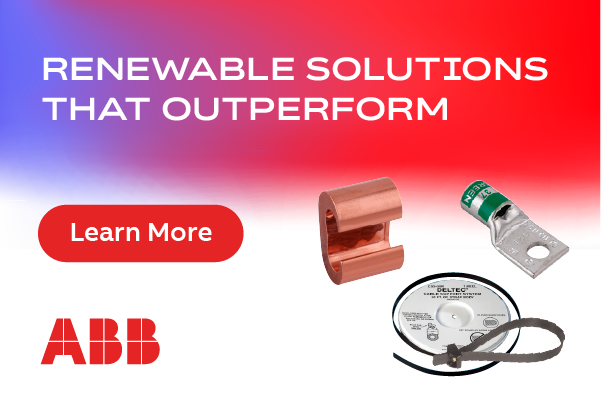Controlling Erosion: Protecting & repairing turbine blades
 In the early days of wind turbines, blades were built like old Cadillacs, with the strength to take hits with minimal damage. In recent years, however, as turbines have grown taller and blades have grown larger and larger, the materials used to build them have become lighter. This is a good thing for overall efficiency of a turbine but, unfortunately, it also means that blades are more vulnerable to damage.
In the early days of wind turbines, blades were built like old Cadillacs, with the strength to take hits with minimal damage. In recent years, however, as turbines have grown taller and blades have grown larger and larger, the materials used to build them have become lighter. This is a good thing for overall efficiency of a turbine but, unfortunately, it also means that blades are more vulnerable to damage.
Blades face a lot of environmental and weather challenges while beating in the wind, and any resulting damage can impact efficiency, production, and a wind farm owner’s return-on-investment (ROI). Most blade damage is the result of erosion, and research shows that it can lead to a loss of annual energy production (AEP) of up to 20%.
This figure highlights why it’s extremely important turbine manufacturers and owners stay ahead of erosion problems, ensuring blades are maintained and kept in ideal working condition. This is true not only after installation in the field, but also beforehand, during manufacturing. Starting with robust protection against erosion is a significant step to ensuring a successful turbine.
Early protection
Made of lightweight materials (materials vary, but often include fiberglass and/or polypropylene), today’s turbine blades measure upwards of 40 meters, with larger blades achieving tip speeds above 200 miles-per-hour (mph). Traveling at this speed, blade erosion can be anticipated in almost any installation—regardless of a turbine’s location, hub height, manufacturer, material, or any other factor.
The degree of erosion that will take place is, of course, dependent on the environmental conditions at the specific turbine location, with a combination of high-particle, loaded air and rain having the most significant impact. But even in installations where these conditions aren’t likely or prevalent, manufacturers should take steps to protect blades before service life begins.
The most useful tools currently available to manufacturers for this purpose is either a polyurethane coating, which is designed for application via brush or casting, or a wind protection tape. There are a number of advantages to applying a leading-edge solution during the manufacturing process, as opposed to in the field. Benefits include:
• A controlled environment. In a manufacturing facility, environmental, temperature, and weather variables can be controlled. As a result, moisture from rain or snow, dirt from blowing dust or sand, and temperature extremes, which could hinder an application process in the field, simply aren’t a concern.
• Balanced blades. Because the balance of the blades is critical to turbine performance at a wind farm, uniform application of a protective coating is vital. Again, a controlled manufacturing facility allows workers to apply any coating or tape properly to each individual blade, taking precise measures to avoid any weight imbalances.
• Better safety. The ability to apply coatings during the manufacturing process, before turbines are installed onsite, removes the potential hazards of workers performing this work at height and on platforms. Plus, with significantly fewer safety concerns and weather-related variables, coatings can be applied more uniformly and efficiently. The better the erosion coverage, the less likely later repairs will be required.
• Cost savings. The combination of factors listed above adds up to a process that’s far simpler than field application or repairs, ultimately making it much more cost-effective. Transportation aside, simply consider the time and costs associated with sending workers and any equipment required (vehicles, cranes, fall protection, etc.) to a wind farm site, which is generally found in remote locations. Time is money and, as a result, safeguarding against turbine blade damage early on can make a significant difference on the pocketbook.
Field solutions
 Once turbines are installed at a wind farm, it’s imperative owners inspect them on a regular basis to keep on top of any erosion damage as it arises. Periodic inspections help owners better understand their individual erosion environments, while addressing minor issues before they can cause any structural damage or efficiency losses.
Once turbines are installed at a wind farm, it’s imperative owners inspect them on a regular basis to keep on top of any erosion damage as it arises. Periodic inspections help owners better understand their individual erosion environments, while addressing minor issues before they can cause any structural damage or efficiency losses.
Typically, erosion can be noted earliest at the leading edge of a blade’s tip, where damage to the paint or coating becomes visible. If left untreated, this process continues toward the blade root and at the pressure and the suction side of a blade. At this stage, the coating might be blasted away at the leading edge in the tip area. Under extreme conditions, erosion can progress further to and through matrix resins, effecting fiberglass layers and causing delamination and structural damages.
When regular inspections are conducted—even from the ground—this progression of damage can be halted early on, and a preventive maintenance plan can be developed. In the field, wind protection tape is often the best choice to repair damage and protect against further erosion. It provides a consistent solution, with a uniformed thickness and finish.
As the chemistry of a coating may be affected by field conditions, such as humidity and temperature, tapes also provide better resistance to such variables. Moreover, tape offers a more foolproof application process that makes it easy to see if any corrections need to be made.
Lasting protection
Many installations of wind protection tape have passed the seven-year mark with the material still performing well. And, although the coating products discussed here are newer, preliminary data shows that coatings may even outlast tape in the long run.
The longevity of both of these solutions should give manufacturers and owners confidence in the investments they make in blade erosion protection. Whether implemented in the factory or in the field, erosion protection with a coating or tape can often pay for itself in less than a year. With these solutions, rotor blades can stay functioning at their peak for as long as possible, allowing wind turbines to produce reliable and efficient renewable energy.
Santhosh Krishna Chandrabalan is the Technical Business Development leader in wind energy, with 3M’s Renewable Energy Division.
3M
www.3m.com
Author: Santhosh Krishna Chandrabalan
Volume: May/June 2014








